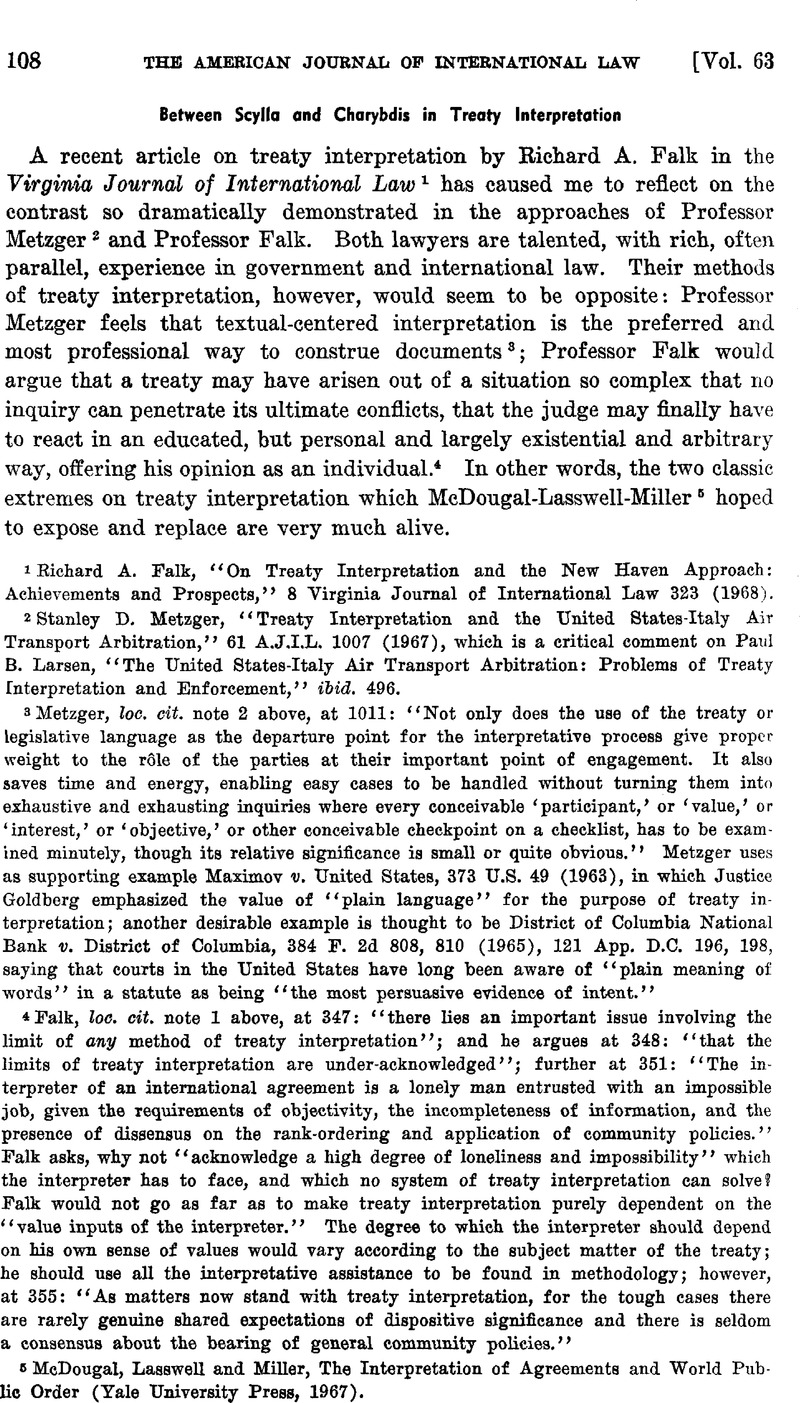No CrossRef data available.
Article contents
Between Scylla and Charybdis in Treaty Interpretation
Published online by Cambridge University Press: 28 March 2017
Abstract

- Type
- Notes and Comments
- Information
- Copyright
- Copyright © The American Society of International Law 1969
References
1 Richard A. Falk, “On Treaty Interpretation and the New Haven Approach: Achievements and Prospects,” 8 Virginia Journal of International Law 323 (1968).
2 Stanley D. Metzger, ‘ ‘ Treaty Interpretation and the United States-Italy Air Transport Arbitration,” 61 A.J.I.L. 1007 (1967), which is a critical comment on Paul B. Larsen, “The United States-Italy Air Transport Arbitration: Problems of Treaty Interpretation and Enforcement,” ibid. 496.
3 Metzger, loc. cit. note 2 above, at 1011: “Not only does the use of the treaty or legislative language as the departure point for the interpretative process give proper weight to the rôle of the parties at their important point of engagement. It also saves time and energy, enabling easy cases to be handled without turning them into exhaustive and exhausting inquiries where every conceivable ‘participant,’ or ‘value,’ or 'interest,’ or ‘objective,’ or other conceivable checkpoint on a checklist, has to be examined minutely, though its relative significance is small or quite obvious.” Metzger uses as supporting example Maximov v. United States, 373 U.S. 49 (1963), in which Justice Goldberg emphasized the value of “plain language” for the purpose of treaty interpretation; another desirable example is thought to be District of Columbia National Bank v. District of Columbia, 384 F. 2d 808, 810 (1965), 121 App. D.C. 196, 198, saying that courts in the United States have long been aware of “plain meaning of words” in a statute as being “the most persuasive evidence of intent.“
4 Falk, loc. cit. note 1 above, at 347: ‘ ‘ there lies an important issue involving the limit of any method of treaty interpretation“; and he argues at 348: “that the limits of treaty interpretation are under-acknowledged“; further at 351: “The interpreter of an international agreement is a lonely man entrusted with an impossible job, given the requirements of objectivity, the incompleteness of information, and the presence of dissensus on the rank-ordering and application of community policies.“ Falk asks, why not “acknowledge a high degree of loneliness and impossibility” which the interpreter has to face, and which no system of treaty interpretation can solve! Falk would not go as far as to make treaty interpretation purely dependent on the “value inputs of the interpreter.” The degree to which the interpreter should depend on his own sense of values would vary according to the subject matter of the treaty; he should use all the interpretative assistance to be found in methodology; however, at 355: “As matters now stand with treaty interpretation, for the tough cases there are rarely genuine shared expectations of dispositive significance and there is seldom a consensus about the bearing of general community policies.“
5 McDougal, Lasswell and Miller, The Interpretation of Agreements and World Public Order (Yale University Press, 1967).
6 Falk, loc. cit. note 1 above, at 353.
7 South West Africa Cases, [1966] I.C.J. Rep. 6.
8 Air Traffic Eights Dispute (United States v. France) (1963), 3 Int. Legal Materials 668; digested in 58 A.J.I.L. 1016 (1964); see Larsen, “Arbitration of the United States-France Air Traffic Rights Dispute,” 30 Journal of Air Law and Commerce 231 (1964).
9 ‘Isthmian Canal Convention, signed Nov. 18, 1903; 33 Stat. 2234; Treaty Series, No. 431; 2 Malloy 1349; 3 A.J.I.L. Supp. 130 (1909).




